sensor JAGUAR XJ6 1994 2.G Electrical Diagnostic Manual
[x] Cancel search | Manufacturer: JAGUAR, Model Year: 1994, Model line: XJ6, Model: JAGUAR XJ6 1994 2.GPages: 327, PDF Size: 13.73 MB
Page 43 of 327
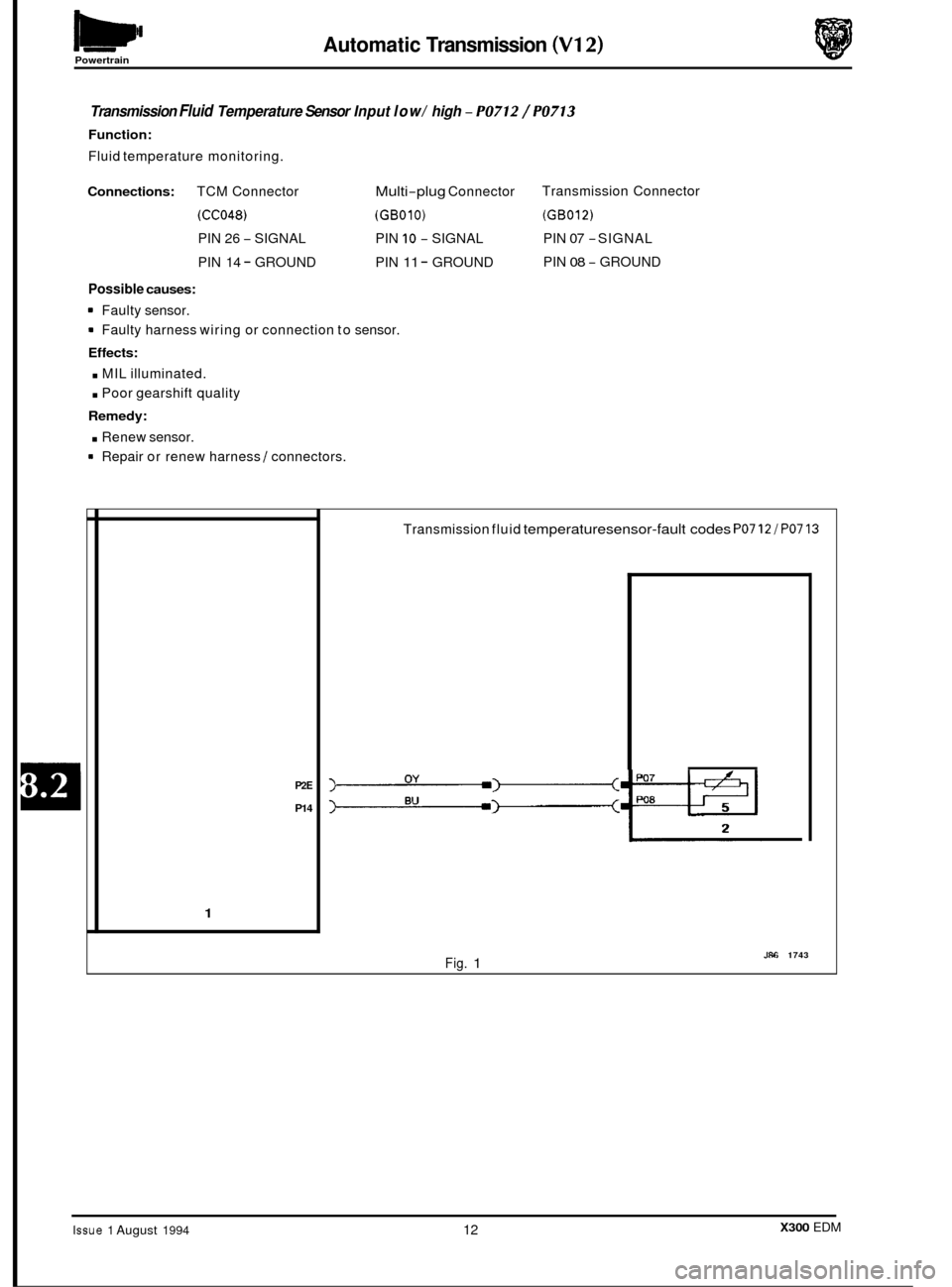
Automatic Transmission (V12) Powertrain
Transmission Fluid Temperature Sensor Input low/ high - PO712 / PO713
Function:
Fluid temperature monitoring.
Connections: TCM Connector Multi-plug Connector Transmission Connector
(CC048) (GBOIO) (GB012)
PIN 26 - SIGNAL
PIN 14
- GROUND PIN
10 - SIGNAL
PIN
11 - GROUND PIN
07 -SIGNAL
PIN
08 - GROUND
Possible causes:
8 Faulty sensor.
8 Faulty harness wiring or connection to sensor.
Effects:
. MIL illuminated.
. Poor gearshift quality
Remedy:
. Renew sensor.
8 Repair or renew harness I connectors.
P2E
P14
Transmission fluid temperaturesensor-fault codes P0712/P0713
1
Fig. 1 JR6 1743
0
0
X300 EDM Issue 1 August 1994 12
Page 44 of 327
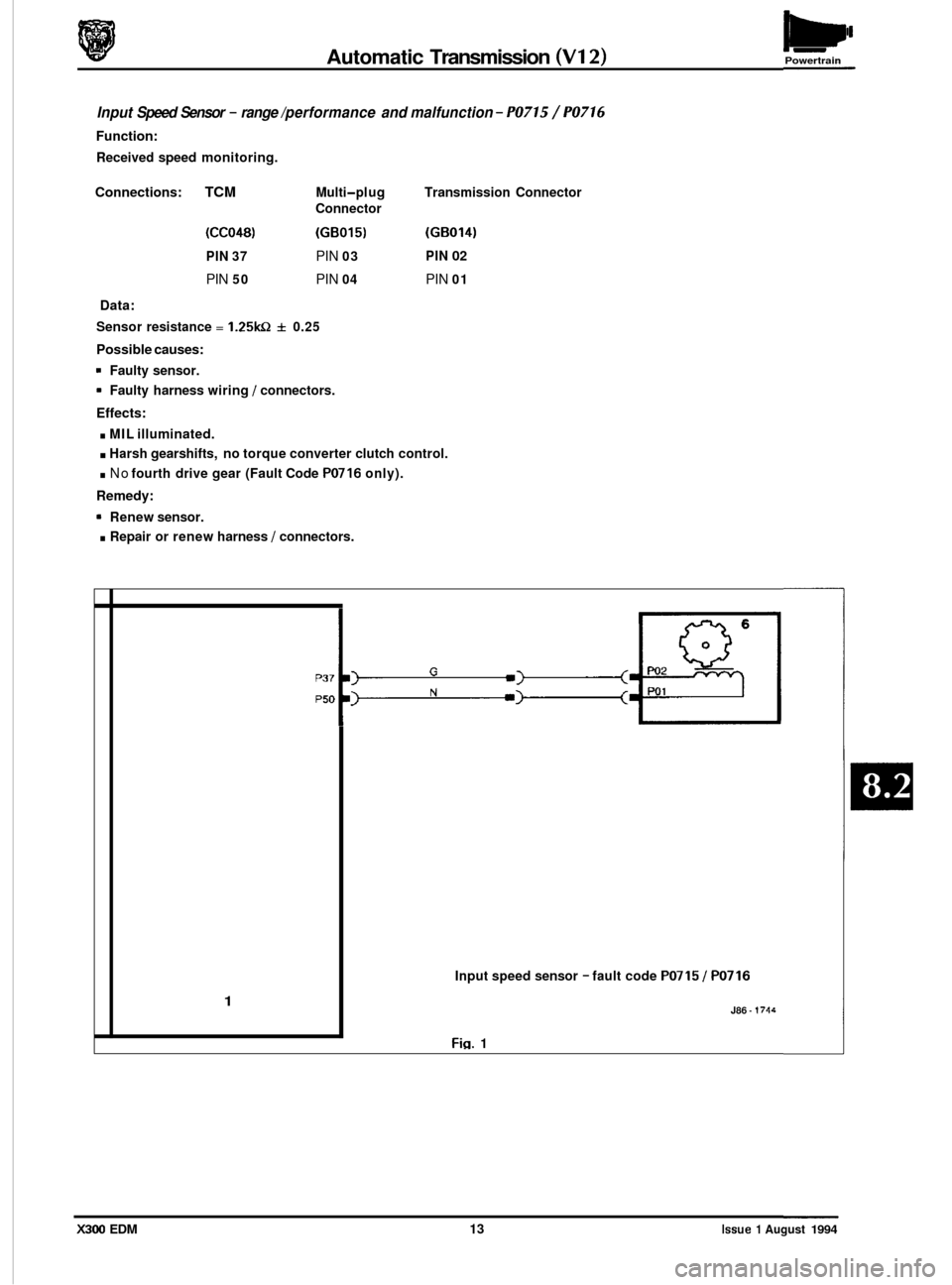
Automatic Transmission (V12) Powertrain
Input Speed Sensor - range /performance and malfunction - PO715 / PO716
Function:
Received speed monitoring.
Transmission Connector
(GB014)
PIN 02
PIN 01
Connections: TCM Multi-pl ug
Connector
(CC048) (GB015)
PIN 37 PIN 03
PIN 50 PIN 04
Data:
Sensor resistance = 1.25kQ f 0.25
Possible causes:
9 Faulty sensor.
9 Faulty harness wiring 1 connectors.
Effects:
. MIL illuminated.
. Harsh gearshifts, no torque converter clutch control.
. No fourth drive gear (Fault Code PO716 only).
Remedy:
. Repair or renew harness 1 connectors.
Renew sensor.
0
0
1
Input speed sensor - fault code PO715 / PO716
J86 - 1714
Fig. 1
X300 EDM 13 Issue 1 August 1994
Page 45 of 327
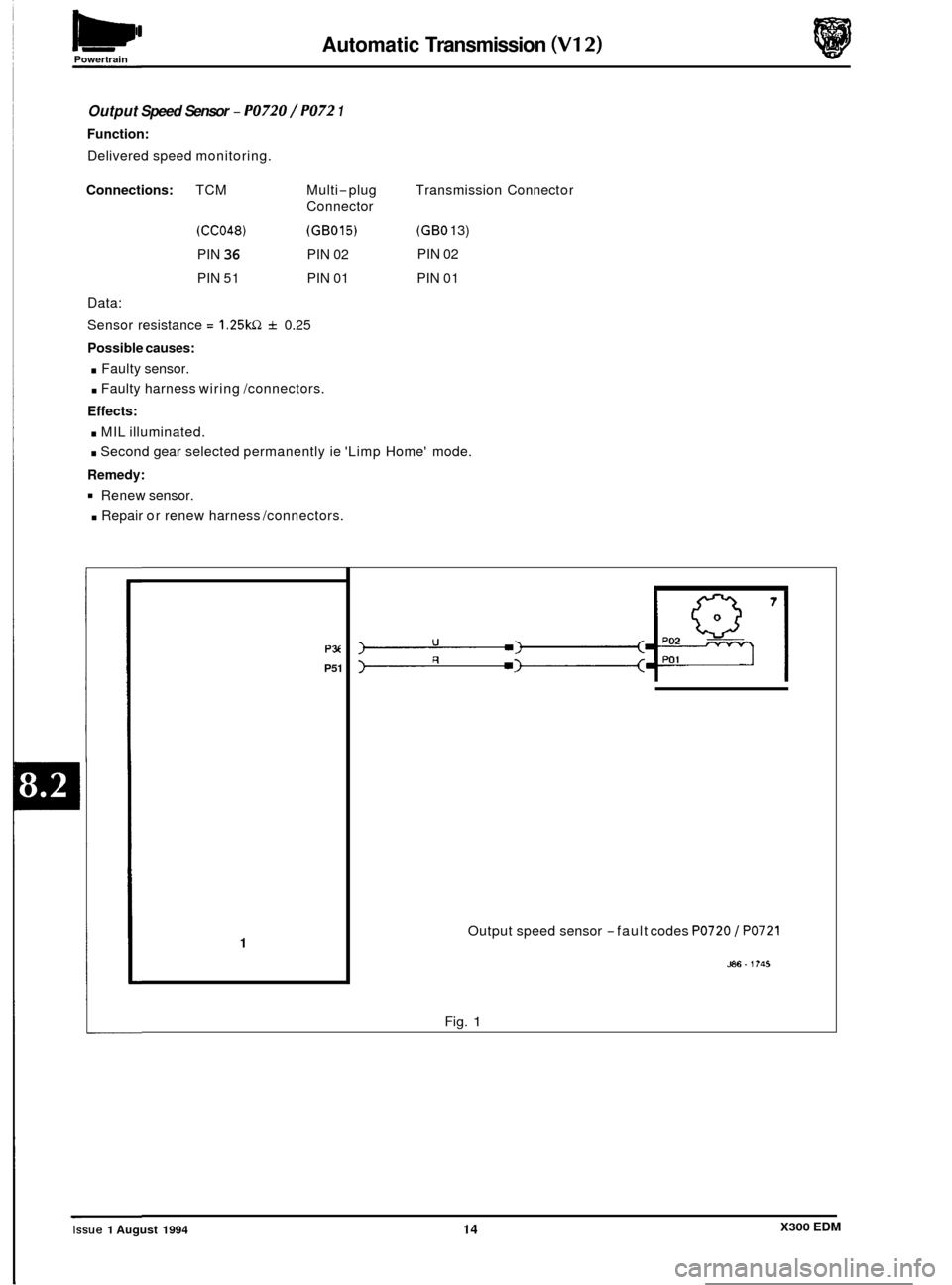
Automatic Transmission (V12) Powertrain
Output Speed Sensor - PO720 / PO72 1
Function:
Delivered speed monitoring.
Connections: TCM Multi-plug
Connector
(CC048) (GB015)
PIN 36 PIN 02
PIN
51 PIN 01
Data:
Sensor resistance = 1.25kQ f 0.25
Possible causes:
. Faulty sensor.
. Faulty harness wiring /connectors.
Effects:
. MIL illuminated. Transmission
Connect or
(GBO 13)
PIN 02
PIN 01
. Second gear selected permanently ie 'Limp Home' mode.
Remedy:
. Repair or renew harness /connectors.
Renew
sensor.
PX
P51
1 Output speed sensor -fault codes PO720 / PO721
586. 1?45
Fig. 1
0
0
0
X300 EDM Issue 1 August 1994 14
Page 65 of 327
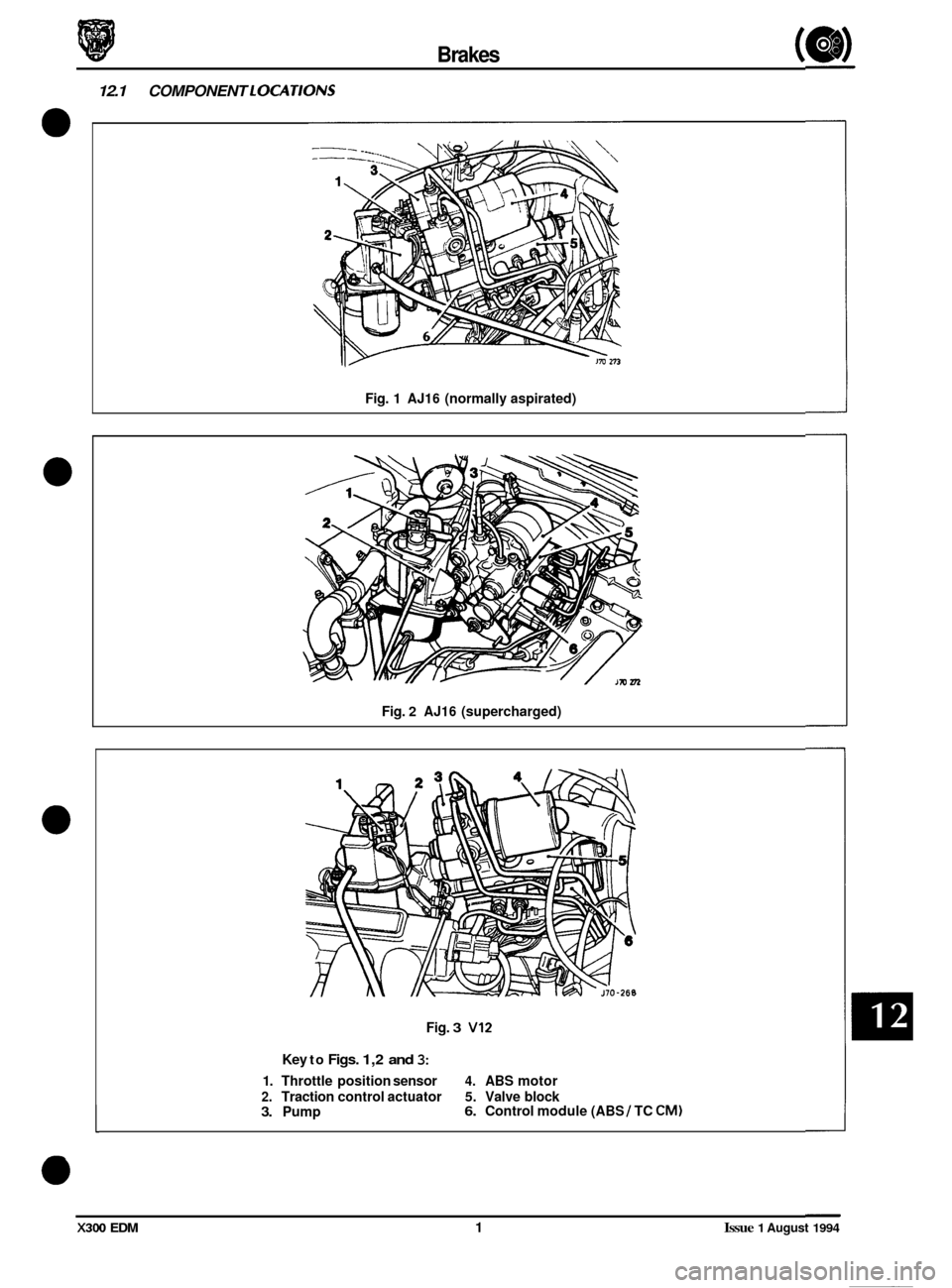
0
0
0
Brakes (
12.1 COMPONENT LOCATlONS
Fig. 1 AJ16 (normally aspirated)
Fig.
2 AJ16 (supercharged)
Fig.
3 VI2
Key to Figs. 1,2 and 3:
1. Throttle position sensor 4. ABS motor
2. Traction control actuator 5. Valve block 3. Pump 6. Control module (ABS / TC CM)
X300 EDM 1 Issue 1 August 1994
Page 66 of 327
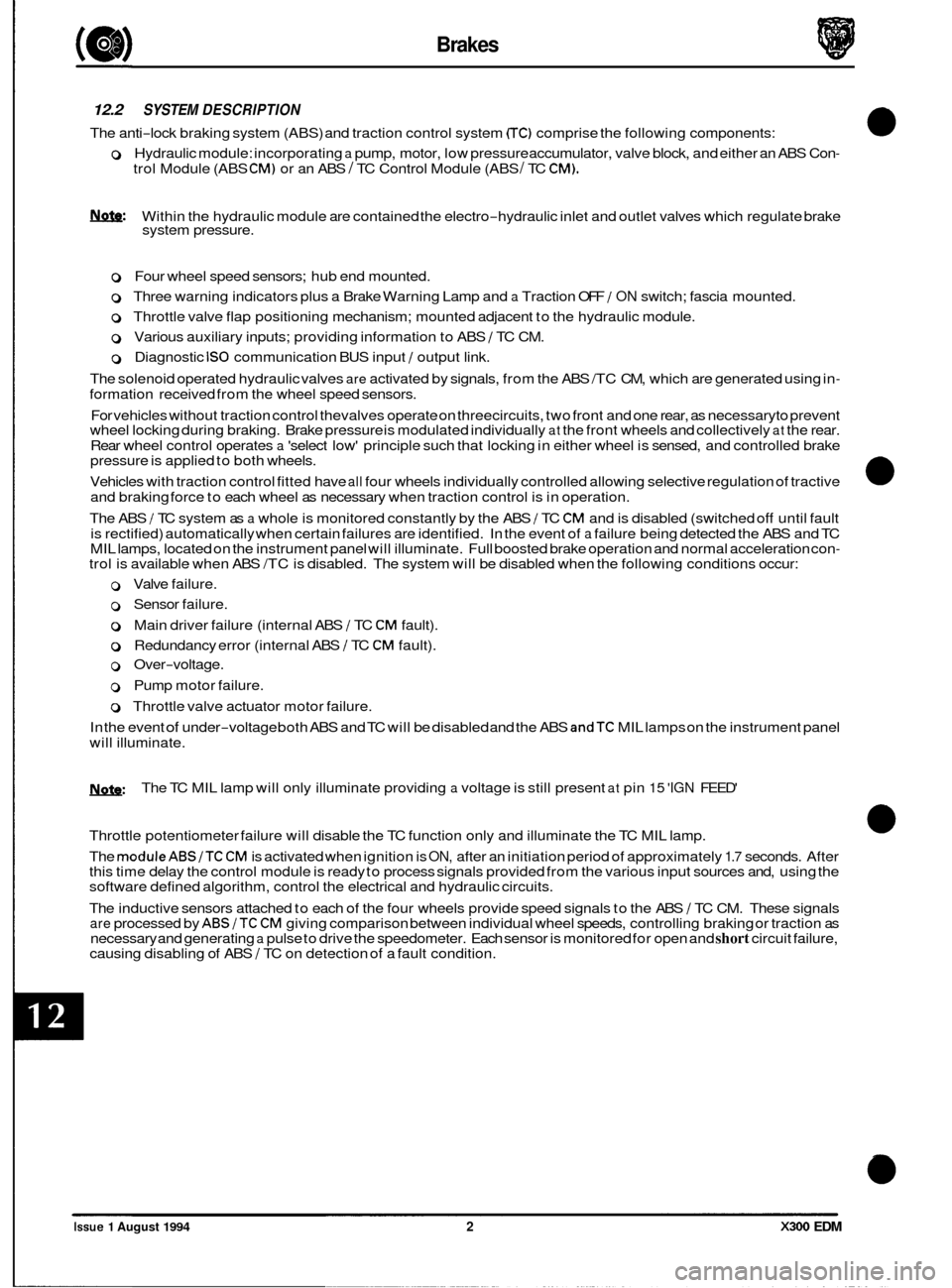
Brakes
12.2 SYSTEM DESCRIPTION
The anti-lock braking system (ABS) and traction control system CTC) comprise the following components:
0 Hydraulic module: incorporating a pump, motor, low pressure accumulator, valve block, and either an ABS Con-
trol Module (ABS CM) or an ABS / TC Control Module (ABS / TC CM).
U!&: Within the hydraulic module are contained the electro-hydraulic inlet and outlet valves which regulate brake
system pressure.
o Four wheel speed sensors; hub end mounted.
0 Three warning indicators plus a Brake Warning Lamp and a Traction OFF / ON switch; fascia mounted.
0 Throttle valve flap positioning mechanism; mounted adjacent to the hydraulic module.
0 Various auxiliary inputs; providing information to ABS / TC CM.
0 Diagnostic IS0 communication BUS input / output link.
The solenoid operated hydraulic valves
are activated by signals, from the ABS /TC CM, which are generated using in-
formation received from the wheel speed sensors.
For vehicles without traction control thevalves operate on threecircuits, two front and one rear, as necessaryto prevent
wheel locking during braking. Brake pressure is modulated individually
at the front wheels and collectively at the rear.
Rear wheel control operates
a 'select low' principle such that locking in either wheel is sensed, and controlled brake
pressure is applied to both wheels.
Vehicles with traction control fitted have
all four wheels individually controlled allowing selective regulation of tractive
and braking force to each wheel as necessary when traction control is in operation.
The ABS
/ TC system as a whole is monitored constantly by the ABS / TC CM and is disabled (switched off until fault
is rectified) automatically when certain failures are identified. In the event of
a failure being detected the ABS and TC
MIL lamps, located on the instrument panel will illuminate. Full boosted brake operation and normal acceleration con- trol is available when ABS /TC is disabled. The system will be disabled when the following conditions occur:
0 Valve failure.
0 Sensor failure.
0 Main driver failure (internal ABS / TC CM fault).
0 Redundancy error (internal ABS / TC CM fault).
0 Over-voltage.
0 Pump motor failure.
0 Throttle valve actuator motor failure.
In the event
of under-voltage both ABS and TC will be disabled and the ABS andTC MIL lamps on the instrument panel
will illuminate.
U!&: The TC MIL lamp will only illuminate providing a voltage is still present at pin 15 'IGN FEED'
Throttle potentiometer failure will disable the TC function only and illuminate the TC MIL lamp.
The
moduleABS/TC CM is activated when ignition is ON, after an initiation period of approximately 1.7 seconds. After
this time delay the control module is ready to process signals provided from the various input sources and, using the
software defined algorithm, control the electrical and hydraulic circuits.
The inductive sensors attached to each of the four wheels provide speed signals to the ABS
/ TC CM. These signals are processed by ABS/TC CM giving comparison between individual wheel speeds, controlling braking or traction as
necessary and generating a pulse to drive the speedometer. Each sensor is monitored for open and short circuit failure,
causing disabling of ABS / TC on detection of a fault condition.
Issue 1 August 1994 2 X300 EDM
Page 67 of 327
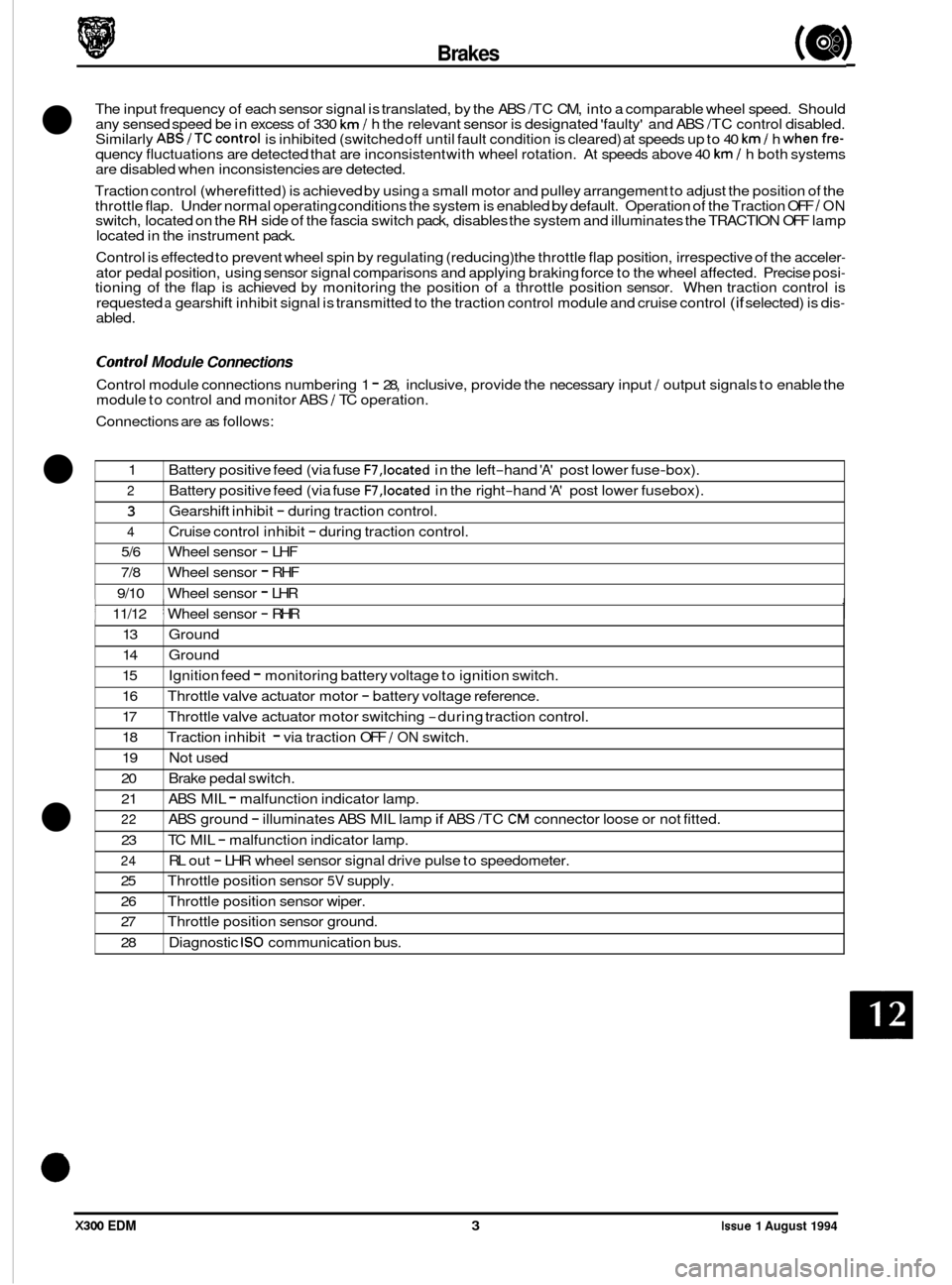
Brakes (a)
The input frequency of each sensor signal is translated, by the ABS /TC CM, into a comparable wheel speed. Should
any sensed speed be in excess of 330 km / h the relevant sensor is designated 'faulty' and ABS /TC control disabled.
Similarly ABS/TCcontrol is inhibited (switched off until fault condition is cleared) at speeds up to 40 km/ h whenfre- quency fluctuations are detected that are inconsistent with wheel rotation. At speeds above 40 km / h both systems
are disabled when inconsistencies are detected.
Traction control (where fitted) is achieved by using
a small motor and pulley arrangement to adjust the position of the
throttle flap. Under normal operating conditions the system is enabled by default. Operation of the Traction OFF / ON switch, located on the RH side of the fascia switch pack, disables the system and illuminates the TRACTION OFF lamp
located in the instrument pack.
Control is effected to prevent wheel spin by regulating (reducing) the throttle flap position, irrespective of the acceler
-
ator pedal position, using sensor signal comparisons and applying braking force to the wheel affected. Precise posi- tioning of the flap is achieved by monitoring the position of a throttle position sensor. When traction control is
requested
a gearshift inhibit signal is transmitted to the traction control module and cruise control (if selected) is dis- abled.
1
2
3
4
Battery positive feed (via fuse F7,located in the left-hand 'A' post lower fuse-box).
Battery positive feed (via fuse
F7,located in the right-hand 'A' post lower fusebox).
Gearshift inhibit
- during traction control.
Cruise control inhibit
- during traction control.
5/6 Wheel sensor
- LHF
7/8 Wheel sensor
- RHF
9/10 Wheel sensor
- LHR
Control Module Connections
Control module connections numbering 1 - 28, inclusive, provide the necessary input / output signals to enable the
module to control and monitor ABS / TC operation.
Connections are as follows:
13 Ground
14 Ground
15
16
17
18
19 Not used
20 Brake pedal switch.
21
22
23
24
25
26 Throttle position sensor wiper.
27 Throttle position sensor ground.
28 Diagnostic
IS0 communication bus.
Ignition
feed
- monitoring battery voltage to ignition switch.
Throttle valve actuator motor
- battery voltage reference.
Throttle valve actuator motor switching
-during traction control.
Traction inhibit
- via traction OFF / ON switch.
ABS MIL
- malfunction indicator lamp.
ABS ground
- illuminates ABS MIL lamp if ABS /TC CM connector loose or not fitted.
TC MIL
- malfunction indicator lamp.
RL out
- LHR wheel sensor signal drive pulse to speedometer.
Throttle position sensor
5V supply.
I 1 11/12 1 Wheel sensor - RHR 1
X300 EDM 3 Issue 1 August 1994
Page 68 of 327
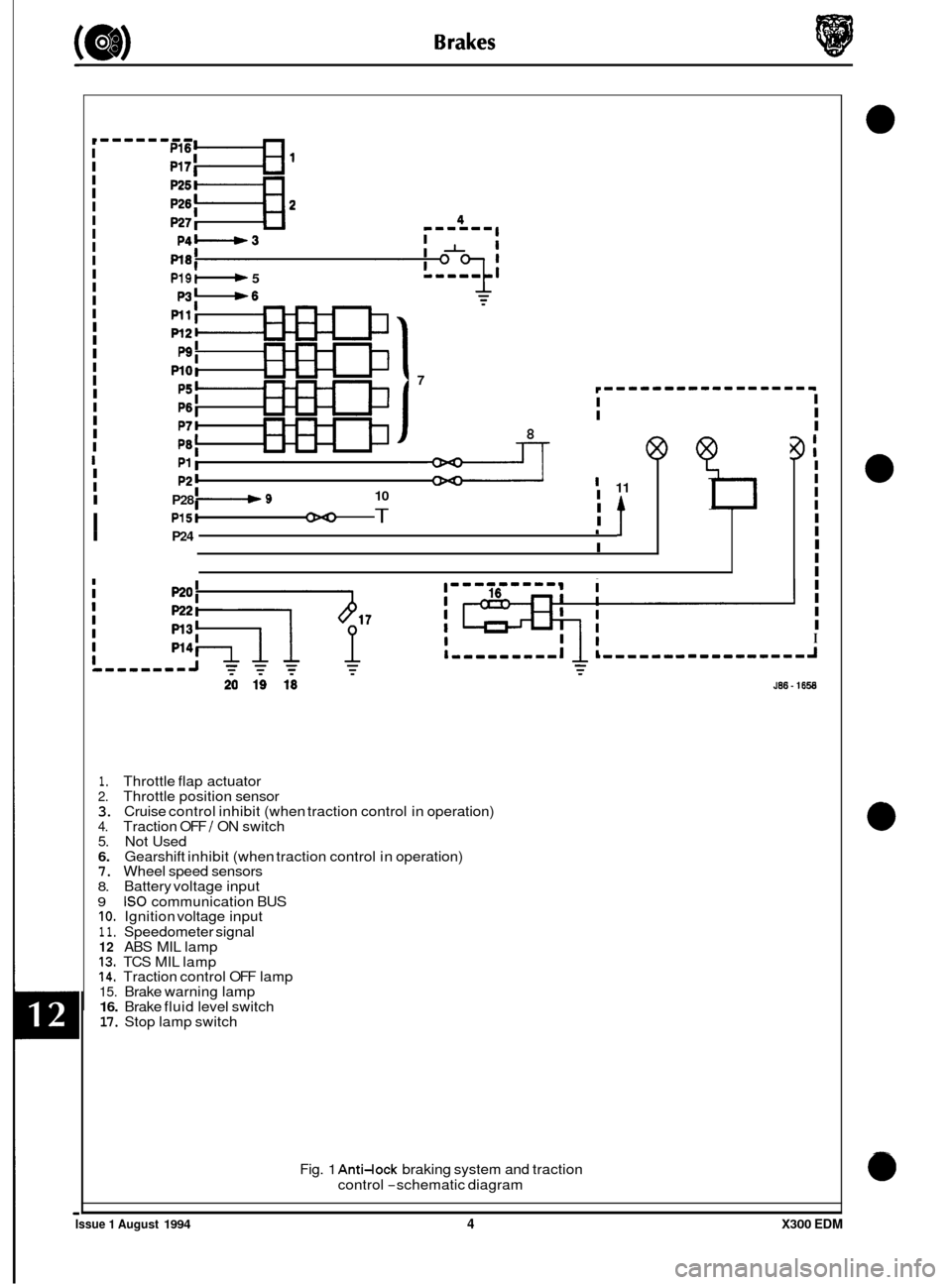
I I I I I I I I
I
I
I 11 I I
I
I
I I P24 1
I
I
I
I
I I I I I I I I
I
I
I
P19: 5
P3-6
7
8
I I I I P28 I-+ 9 10
I P15t T
I
I I I
I
,t I
I
I I I I I I I I
I
I I I
1. Throttle flap actuator 2. Throttle position sensor 3. Cruise control inhibit (when traction control in operation) 4. Traction OFF / ON switch 5. Not Used 6. Gearshift inhibit (when traction control in operation) 7. Wheel speed sensors 8. Battery voltage input
9 IS0 communication BUS IO. Ignition voltage input
1 1. Speedometer signal 12 ABS MIL lamp 13. TCS MIL lamp 14. Traction control OFF lamp 15. Brake warning lamp 16. Brake fluid level switch 17. Stop lamp switch
Fig.
1 Anti-lock braking system and traction
control
-schematic diagram
0
0
Issue 1 August 1994 4 X300 EDM
Page 69 of 327
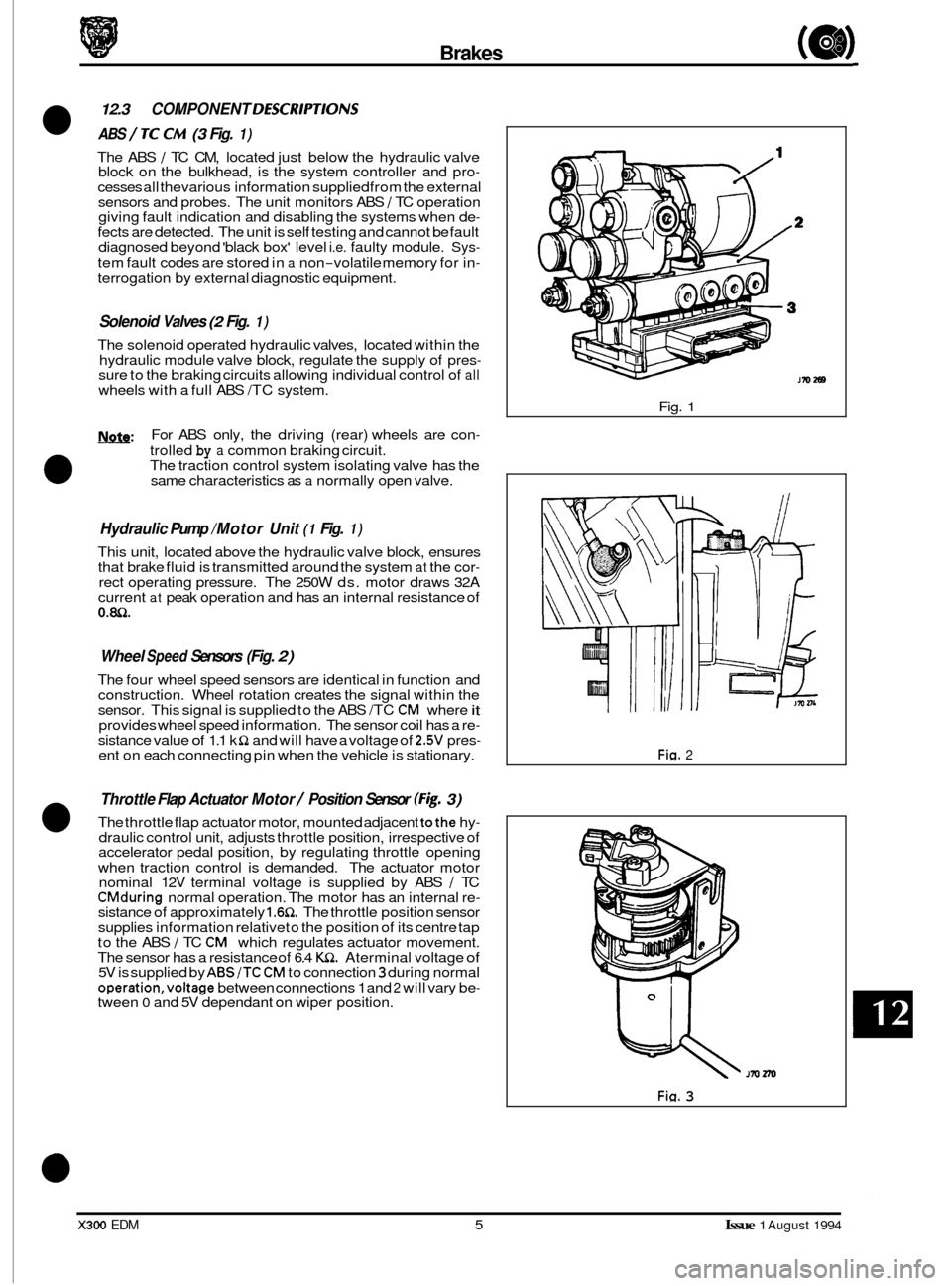
Brakes (a)
12.3 COMPONENT DESCRlPTlONS
ABS / TC CM (3 Fig. 1)
The ABS / TC CM, located just below the hydraulic valve
block on the bulkhead, is the system controller and pro-
cesses all thevarious information supplied from the external
sensors and probes. The unit monitors ABS / TC operation
giving fault indication and disabling the systems when de- fects are detected. The unit is self testing and cannot be fault
diagnosed beyond 'black box' level i.e. faulty module. Sys-
tem fault codes are stored in a non-volatile memory for in- terrogation by external diagnostic equipment.
Solenoid Valves (2 Fig. 1)
The solenoid operated hydraulic valves, located within the
hydraulic module valve block, regulate the supply of pres- sure to the braking circuits allowing individual control of all wheels with a full ABS /TC system.
Nnfe: For ABS only, the driving (rear) wheels are con-
trolled by a common braking circuit.
The traction control system isolating valve has the
same characteristics as
a normally open valve. a
Hydraulic Pump /Motor Unit (1 Fig. 1)
This unit, located above the hydraulic valve block, ensures
that brake fluid is transmitted around the system at the cor- rect operating pressure. The 250W ds. motor draws 32A
current at peak operation and has an internal resistance of 0.m.
Wheel Speed Sensors (Fig. 2)
The four wheel speed sensors are identical in function and
construction. Wheel rotation creates the signal within the
sensor. This signal is supplied to the ABS /TC
CM where it provides wheel speed information. The sensor coil has a re- sistance value of 1.1 k Q and will have a voltage of 2.5V pres- ent on each connecting pin when the vehicle is stationary.
Throttle Flap Actuator Motor / Position Sensor (Fig. 3)
The throttle flap actuator motor, mounted adjacent tothe hy- draulic control unit, adjusts throttle position, irrespective of
accelerator pedal position, by regulating throttle opening
when traction control is demanded. The actuator motor
nominal 12V terminal voltage is supplied by ABS
/ TC CMduring normal operation. The motor has an internal re- sistance of approximately 1.6Q. The throttle position sensor
supplies information relative to the position of its centre tap
to the ABS
/ TC CM which regulates actuator movement.
The sensor has a resistance of 6.4 K!2. Aterminal voltage of 5V is supplied by ABS/TC CM to connection 3 during normal
operation,voltage between connections 1 and 2 will vary be- tween 0 and 5V dependant on wiper position.
Fig. 1
Fig. 2
Jrn 270
Fia. 3
X300 EDM 5 Issue 1 August 1994
Page 70 of 327
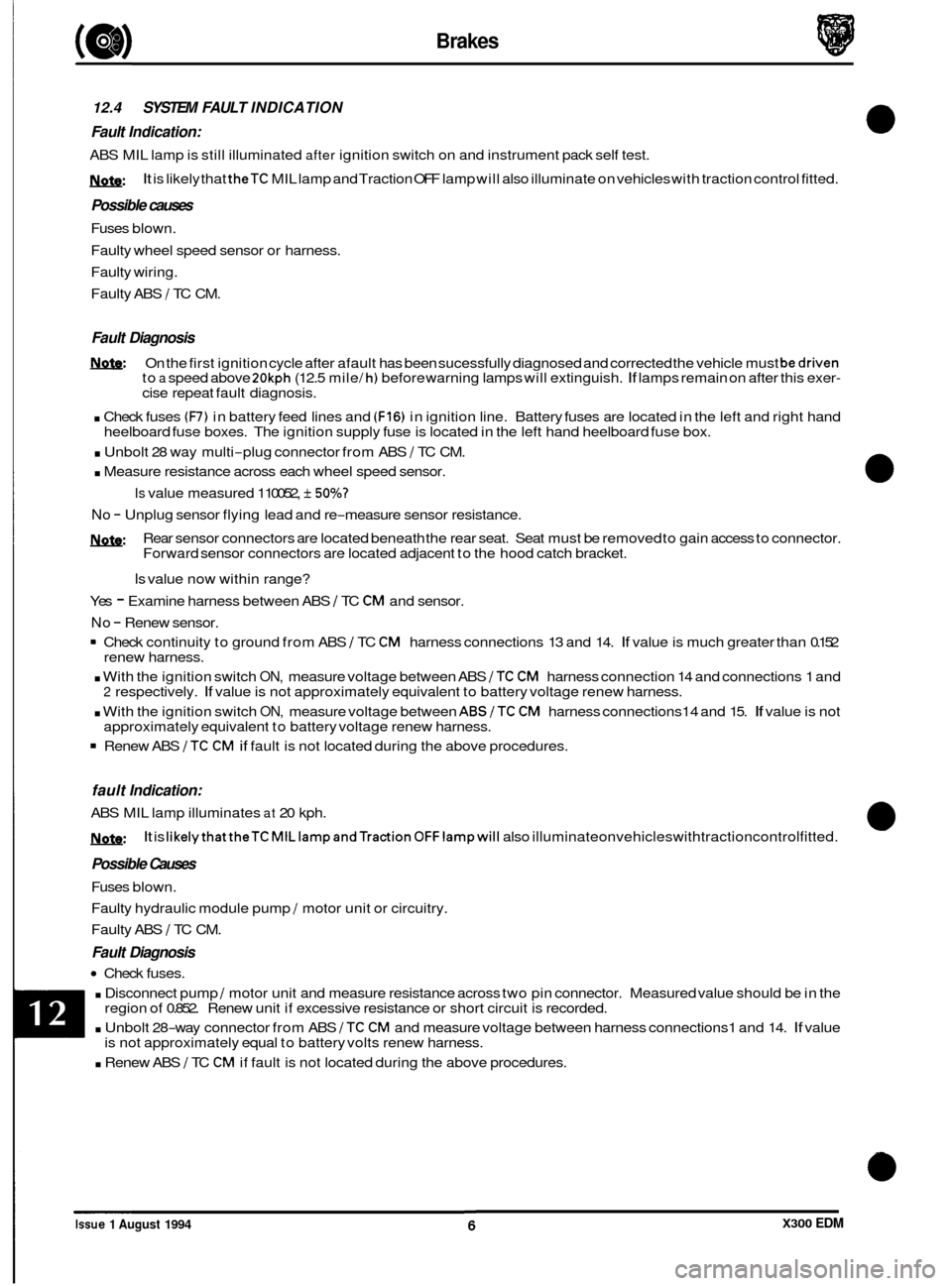
Brakes
12.4 SYSTEM FAULT INDICATION
Fault Indication:
ABS MIL lamp is still illuminated after ignition switch on and instrument pack self test.
h:
Possible causes
Fuses blown.
Faulty wheel speed sensor or harness.
Faulty wiring.
Faulty ABS
/ TC CM.
It is likely that theTC MIL lamp and Traction OFF lamp will also illuminate on vehicles with traction control fitted.
Fault Diagnosis
On the first ignition cycle after afault has been sucessfully diagnosed and corrected the vehicle must bedriven to a speed above 20kph (12.5 mile/ h) before warning lamps will extinguish. If lamps remain on after this exer- cise repeat fault diagnosis.
. Check fuses (F7) in battery feed lines and (F16) in ignition line. Battery fuses are located in the left and right hand
. Unbolt 28 way multi-plug connector from ABS / TC CM.
. Measure resistance across each wheel speed sensor.
No - Unplug sensor flying lead and re-measure sensor resistance.
N&:
heelboard fuse boxes. The ignition supply fuse is located in the left hand heelboard fuse box.
Is value measured 1 10052, f 50%?
Rear sensor connectors are located beneath the rear seat. Seat must be removed to gain access to connector.
Forward sensor connectors are located adjacent to the hood catch bracket.
Is value now within range?
Yes
- Examine harness between ABS I TC CM and sensor.
No - Renew sensor.
= Check continuity to ground from ABS 1 TC CM harness connections 13 and 14. If value is much greater than 0.152
renew harness.
. With the ignition switch ON, measure voltage between ABS /TC CM harness connection 14 and connections 1 and 2 respectively. If value is not approximately equivalent to battery voltage renew harness.
. With the ignition switch ON, measure voltage between ABSITC CM harness connections14 and 15. If value is not
approximately equivalent to battery voltage renew harness.
Renew ABS /TC CM if fault is not located during the above procedures.
fault Indication:
ABS MIL lamp illuminates at 20 kph.
m:
Possible Causes
Fuses blown.
Faulty hydraulic module pump
/ motor unit or circuitry.
Faulty ABS
/ TC CM.
Fault Diagnosis
Check fuses.
. Disconnect pump / motor unit and measure resistance across two pin connector. Measured value should be in the
. Unbolt 28-way connector from ABS /TC CM and measure voltage between harness connections1 and 14. If value
. Renew ABS 1 TC CM if fault is not located during the above procedures.
It is IikelythattheTCMILlampandTraction OFFlampwill also illuminateonvehicleswithtractioncontrolfitted.
region of 0.852. Renew unit if excessive resistance or short circuit is recorded.
is not approximately equal to battery volts renew harness.
Issue 1 August 1994 X300 EDM
Page 71 of 327
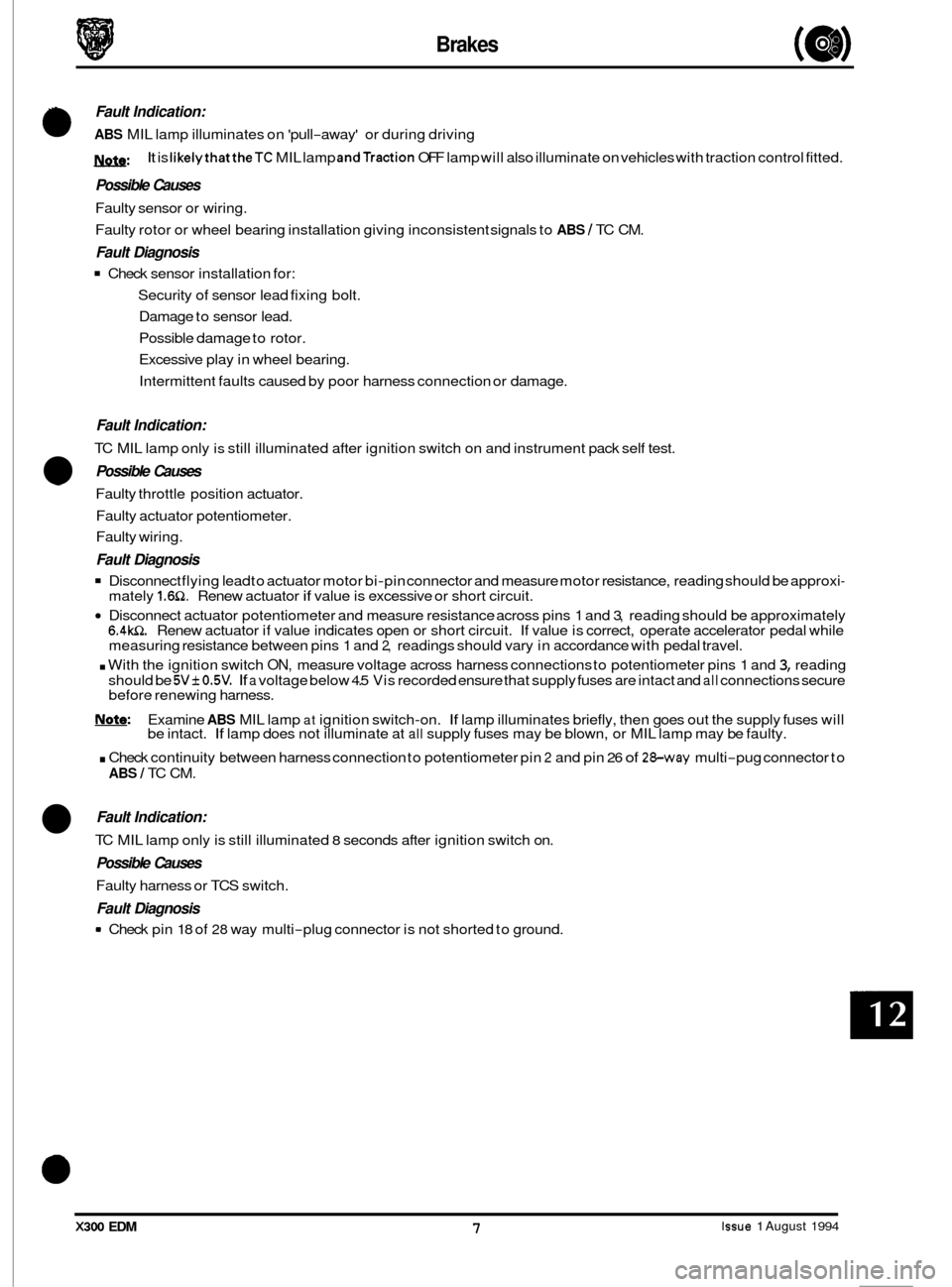
Brakes
Fault Indication:
0 ABS MIL lamp illuminates on 'pull-away' or during driving
U:
Possible Causes
Faulty sensor or wiring.
Faulty rotor or wheel bearing installation giving inconsistent signals to
ABS / TC CM.
Fault Diagnosis
Check sensor installation for:
Security of sensor lead fixing bolt.
Damage to sensor lead.
Possible damage to rotor.
Excessive play in wheel bearing.
Intermittent faults caused by poor harness connection or damage.
It is IikelythattheTC MIL lamp andTraction OFF lamp will also illuminate on vehicles with traction control fitted.
Fault Indication:
TC MIL lamp only is still illuminated after ignition switch on and instrument pack self test.
Possible Causes - Faulty throttle position actuator.
Faulty actuator potentiometer.
Faulty wiring.
Fault Diagnosis
Disconnect flying lead to actuator motor bi-pin connector and measure motor resistance, reading should be approxi- mately 1.6Q. Renew actuator if value is excessive or short circuit.
Disconnect actuator potentiometer and measure resistance across pins 1 and 3, reading should be approximately 6.4kQ. Renew actuator if value indicates open or short circuit. If value is correct, operate accelerator pedal while
measuring resistance between pins 1 and 2, readings should vary in accordance with pedal travel.
. With the ignition switch ON, measure voltage across harness connections to potentiometer pins 1 and 3, reading
should be
5V+ 0.5V. If a voltage below 4.5 Vis recorded ensure that supply fuses are intact and all connections secure
before renewing harness.
m: Examine ABS MIL lamp at ignition switch-on. If lamp illuminates briefly, then goes out the supply fuses will
be intact. If lamp does not illuminate at all supply fuses may be blown, or MIL lamp may be faulty.
. Check continuity between harness connection to potentiometer pin 2 and pin 26 of 28-way multi-pug connector to
ABS I TC CM.
Fault Indication:
TC MIL lamp only is still illuminated 8 seconds after ignition switch on.
Possible Causes
Faulty harness or TCS switch.
Fault Diagnosis
= Check pin 18 of 28 way multi-plug connector is not shorted to ground.
X300 EDM 7 Issue 1 August 1994